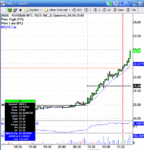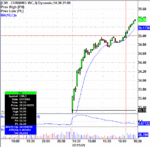Hi Medic,
I've been trying to trade for three years (on top of a day time job) so I can identify with your frustration/confusion. What strikes me about your post are the large losses, it is vital to keep losses small, the classic advice given is never risk more than 2% of your trading capital on any trade. Personally I use the 14 period average true range, I won't trade anything with an ATR>20 cents, ideally about 8-12, I set my initial stop about the ATR. I record every trade and in the last year my average loss is about 10 cents.
I have now come to the conclusion that trading is all about patience, discipline and self control. I read recently that if you can sit all day and not take a trade because there is nothing to trade then you are well on the way to trading successfully, not easy, the temptation to take a trade if you have not traded for a couple of hours is very high.
Hope this helps
Nearlythere
Hi Nearlythere,
Every day I learn so much more and my account is large enough to take my mistakes (even if my stomach is not).
In my 3 month trading experiment I have had 46 winning trades vs. 34 losing trades. To be fair probably half of the winning trades went against me upto my stop loss before turning positive. Any you're right, had I regiliously applied my stop loss strategy my losses would be smaller. I failed at this for three reasons:
1. My trading plan (until recently) was exclusively reversals at R/S. So I would enter against the trend at R/S levels looking for a >5c scalping. This meant commiting to large share sizes to make money of small moves. If the price broke through instead I'd use a market order to ensure I got out and suffered slippage.
2. My broker Scottrade Elite - Only allows a stop order 10c from current price so usually I am not able to place a stop loss order when I place my buy limit order. So I manage the trade manually and stay in longer than I planned (as other indicators and L2 show the reversal that I am looking for). I now use much smaller position sizes to ensure I can place the stop loss when I place the trade. That removes any emotional procastrination when the stop is approaching.
3. I trade large share sizes to reduce the burden of commissions. At 14 bucks RT I need to make $28 + spread to scratch every time I win one/lose one. So I set my stops tight and go for large profits from small moves. The probablity of return on these trades is good as the market does not have to move far and I'm out with $100-200 profit less than a minute later. I have thought about switching to TradeStation or eSignal but am not decided if I will continue yet and dont want to sign up for monthly or dormant fees (none with ST).
The most interesting thing about my experience is the vast range of styles and techniques used to achieve the same aim. For any trade entered you can only be right or wrong and I'm facinated how all the knowleadge and leasons I've learnt can determine which side you end up.
Hope this information helps someone else. Thanks for a great forum.
Mark.




